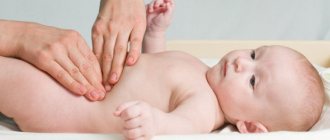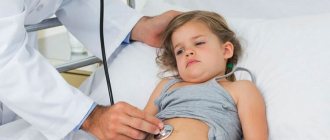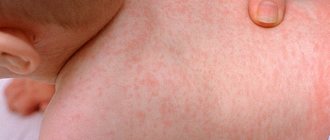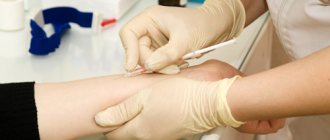The pathogenic microflora that disrupts the proper functioning of the gastrointestinal tract (GIT) includes a representative of lactose-negative enterobacteria - hemolyzing (hemolytic) Escherichia coli. Even a small amount of it can cause severe intestinal upset.
Hemolyzing E. coli in children appears as a result of dietary errors. The cause may be poor-quality infant formula, improper storage of dairy products, etc. Infection in childhood can develop as a result of a decrease in immune defense.
Reasons for the growth of E. coli in infants
The main route of transmission of the bacillus is fecal-oral. Hemolyzing E. coli can enter the child’s body, for example, through mother’s milk, or be acquired during a stay in the maternity ward.
The reasons for the proliferation of E. coli can be different, but most often it is a decrease in the baby’s immune defense. But infection can also be transmitted by a child’s hands, which he constantly puts in his mouth, a pacifier that has fallen to the floor, or a poorly disinfected bottle.
Symptoms of coli infection in infants
Active reproduction of E. coli causes the formation of an imbalance in the microflora of the gastrointestinal tract of the newborn. The baby becomes restless and sleeps poorly. As a rule, against the background of a qualitative redistribution of the bacterial composition of the intestine, the child develops colic - pain in the tummy, which is paroxysmal in nature, and always appears after feeding.
Symptoms of coli infection can be quite varied. And here are the most important ones:
- bloating and increased gas formation;
- rumbling in the intestines;
- disruption of the passage of food through the gastrointestinal tract causes active regurgitation and even vomiting;
- sometimes malabsorption syndrome is diagnosed (impaired absorption of nutrients by the surface of the small intestine);
- diarrhea (stool becomes foamy and is accompanied by a putrid or sour odor);
- the baby begins to lose weight.
If the diarrhea is too severe, the baby becomes dehydrated. The symptoms of this condition are as follows:
- dry tongue and skin;
- rare urination;
- weakness;
- drowsiness;
- increase in general temperature (rare).
Therapy of lactose-negative Escherichia coli in infants
Lactose-negative Escherichia coli is included in the list of opportunistic bacteria. And in a small volume - no more than 5% of the total microflora - it is constantly present in the baby’s intestinal tract. At the same time, she is responsible for many processes:
- responsible for the production of vitamins B and K;
- ensures complete absorption of iron and calcium;
- takes part in metabolic processes.
Exceeding the permissible norm of lactose-negative E. coli manifests itself as:
- increased gas formation;
- frequent regurgitation;
- alternating constipation/diarrhea;
- the presence of particles of undigested food in the stool (if the baby is already receiving complementary foods);
- abdominal pain.
An increase in the total number of lactose-negative Escherichia coli is not considered by doctors as a serious violation. Treatment in this case consists of taking medications containing probiotics (Bifidumbacterin, Colibacterin, etc.) and prebiotics (Duphalac, Hilak-Forte, etc.).
Treatment
Timely treatment will avoid complications
If E. coli is detected in the baby, causing dysbiosis, it is necessary to begin prompt therapy. Hemolytic Escherichia coli in an infant changes the balance of microflora in the intestine in favor of pathogenic strains, so the treatment strategy should be aimed at stabilizing the microbial environment and increasing the number of beneficial bacteria. For this purpose, doctors prescribe pre- and probiotics. These drugs are intended to normalize the intestinal microflora and develop its beneficial components.
- Prebiotics are products that do not contain bacteria themselves, but contain substances that promote the development of beneficial bacterial populations. These products include Duphalac, Hilak-Forte, and others.
- Probiotics contain prepared cultures of beneficial bacteria, which, once in the intestines, begin to colonize and multiply, restoring the imbalance.
Therapy consists of taking drugs from these two groups. Antibiotics are extremely rarely prescribed to young children, since they can have a devastating effect on the fragile, developing child’s body. Dr. Komarovsky’s series of programs is quite widely known. For hemolyzing E. coli in children, Komarovsky, following many experts, recommends giving children rehydration solutions, as well as drugs from the enterosorbent group. The first will allow you to restore the disturbed balance of salts and the amount of fluid in the body (after all, dysbiosis is necessarily accompanied by dehydration), and the second will help reduce intoxication and improve digestion.
Therapy for hemolytic (hemolyzing) Escherichia coli
Hemolytic Escherichia coli should not be present in the gastrointestinal tract of an infant. And her presence is a clear deviation from the norm.
Therapeutic support consists of taking rehydration solutions and sorbents. The drugs restore the disturbed water-salt balance of the body, since the pathology is accompanied by severe intestinal upset.
Drug therapy involves taking bifidobacteria, probiotics and bacteriophages. Antibiotics are prescribed to infants only in exceptional cases. In this case, the doctor focuses not only on the general condition of the child, but also on laboratory data.
Dr. Komarovsky is firmly convinced that exceeding the permissible limit of E. coli is not always a pathology that requires treatment. In addition, taking antibiotics, especially in babies under one year of age, is in no way justified. Drugs from this category are capable of destroying not only “enemies”, but also lacto- and bifidobacteria, which are so necessary for the child.
How dangerous is the pathogen?
For a person with a normally functioning immune system, hemolyzing E. coli does not pose any danger. This is one of the permanent inhabitants of the mucous membranes of the body, which prevents the entry and proliferation of pathogenic microbial flora.
An important point is not only the amount of hemolytic E. coli, but also its ratio (percentage) relative to other representatives of the normal microflora of the human body. One should think about a serious danger for a person of any age only if dysbiosis develops - the number of cells of opportunistic microflora prevails over normal (non-pathogenic).
Among the complications that can be caused by hemolyzing E. coli are:
- various forms of intestinal infection (gastritis, gastroenteritis, gastroenterocolitis);
- inflammation of the genitourinary tract (cystitis, pyelitis);
- damage to the reproductive system (prostatitis in men, salpingoophoritis in women).
In addition, a severe course of intestinal infection is possible, which is complicated by hypovolemic or infectious-toxic shock.
Prevention of coli infection in infants
Do not forget that the main reason for the growth of E. coli is low immune defense, so pediatricians strongly recommend not stopping breastfeeding at least until the child is one year old. After all, breast milk is an inexhaustible source of lactose, which is the supplier of microflora that is beneficial for children’s intestines.
If breastfeeding is not possible for any reason, it is necessary to use formulas containing prebiotics. The pediatrician observing the baby will be able to help with the choice.
To consolidate the effect after completion of treatment, a nursing mother is recommended to adhere to a diet.
While taking medications, it is necessary to undergo intermediate tests. This makes it possible to control the progress of therapy.
If a baby develops symptoms of digestive system dysfunction - especially diarrhea and vomiting - then it is extremely important to receive qualified medical care as soon as possible. Self-treatment can cause serious consequences for the baby.
The intestines contain a large number of microorganisms that regulate digestive processes and facilitate the absorption of food. Among the opportunistic pathogens is hemolytic Escherichia coli. It is worth understanding what it is and what danger it poses.
What is it like?
Hemolyzing bacillus (Escherichia coli) is a bacterium that is particularly resistant to medications and the effects of immunity.
When the body functions normally, opportunistic microorganisms produce vitamin B, fatty acids, and help digest food.
Under the influence of various unfavorable factors, bacteria with hemolytic properties begin to actively multiply and produce toxins that destroy hemolysins (red blood cells).
With the natural renewal of red blood cells, such changes are necessary, but with the pathological development of the process they become dangerous.
Bacteria can remain viable for a long time in feces, water, and soil. When exposed to direct sunlight and boiling, they die. Disinfecting solutions are also harmful to them.
Treatment
Therapy is necessary only in case of severe clinical symptoms, as well as confirmation of the etiology of the disease. If a hemolyzing bacillus is detected in stool tests for dysbacteriosis, then this fact is not a basis for the use of antibiotics and other medications. This applies to both adults and children.
Uncontrolled “preventive” prescription of intestinal antiseptics, antibiotics with a wide spectrum of effects, pro- and prebiotics will only lead to a disruption of the natural microbial balance and a deterioration in the general condition of a person.
Types of Escherichia coli
There are a huge number of varieties of Escherichia. They are combined into several groups:
- enterotoxigenic (form colonies inside the small intestine, release toxic substances, cause diarrhea);
- enteroinvasive (provoke abdominal pain, diarrhea, there are blood impurities in the feces;
- enteropathogenic (the disease develops when climatic conditions change, diarrhea and vomiting are possible);
- enterohemorrhagic - the most dangerous among all varieties, they manifest themselves with pronounced symptoms, provoke the development of hemolytic anemia, and impaired renal function.
Routes of infection
Escherichia coli is transmitted through the oral-fecal route. Among the routes of infection are the following:
- consumption of unboiled water, milk, unwashed fruits and vegetables;
- failure to comply with personal hygiene rules.
Most often, the pathology is observed in children. In adults, such changes occur for the following reasons:
- immunodeficiency;
- uncontrolled use of antibiotics;
- acute respiratory diseases.
Features of appearance and development in men and women
It becomes active in a woman’s intestines, and the bacillus provokes an infectious and inflammatory process. It ends in 7-10 days without causing complications.
The danger comes from inflammation of the genital organs, which develops as a result of increased activity of intestinal bacteria.
Infectious infection occurs for the following reasons:
- Neglect of intimate hygiene rules: irregular washing of the perineum, retention of feces in this area.
- Choosing tight underwear. The genitals sweat, the remains of feces are displaced and penetrate into the vagina.
- Incorrect washing: first you need to wash the anus, and then the genitals.
- Intimacy with a man whose sperm contains an intestinal infection.
Inflammation of the genitourinary system caused by intestinal bacteria is a long-term process that is difficult to treat.
Often pathological changes in women are observed in the intestines, but the symptoms are mild . As a rule, they occur in the presence of stressful situations.
In men, E. coli can also infect the genitals and cause intestinal inflammation. After a week and a half, the pathological process ends on its own.
Inflammation of the genital organs negatively affects urinary and sexual function.
The reason for such changes is the entry of bacteria into the urethra. The development of acute urethritis is noted.
After some time, the symptoms disappear and the disease becomes protracted. Damage to the urethra and genitals is noted.
Escherichia is activated due to hypothermia and severe psycho-emotional stress. A man becomes a carrier of infection and is able to infect his partner.
Features of development in children
In a child, the pathological process begins with errors in nutrition:
- improper storage of dairy products;
- use of low-quality infant formula;
- the presence of E. coli in breast milk;
- individual lactose intolerance.
The development of infection is often due to the immaturity of the digestive system and suppressed immunity.
A bacterium that has penetrated the baby’s gastrointestinal tract disrupts the microflora and provokes dysbacteriosis. There are not enough beneficial microorganisms in the intestines, and a pathogenic microbe helps reduce their numbers.
Why is bacteria dangerous?
An increase in the concentration of hemolytic E. coli increases the risk of developing dysbiosis, when the percentage of pathogenic microflora in the intestine increases significantly. All this may be accompanied by diarrhea, general intestinal upset and other diseases of the gastrointestinal tract.
At the same time, hemolytic E. coli can spread to the mucous membrane of not only the intestines, but also the genitourinary and reproductive organs, which will ultimately cause inflammation of the urethra, urethritis, cystitis, or even prostatitis.
It is not the bacterium itself that is dangerous to humans, but its waste products, which act as a toxin. The body is able to neutralize a certain amount of them, but if they accumulate in excess, symptoms of intoxication appear.
In addition to dysbacteriosis, hemolytic E. coli can provoke the development of the following diseases:
- In men: cystitis, pyelitis, prostatitis, urethritis.
- In women: urethritis, pyelitis, cystitis, salpingoophoritis.
- In children: colitis, gastritis, gastroenteritis, urethritis, pyelitis, cystitis.
The bacterium causes similar diseases in pregnant women, but this can additionally affect the body of the pregnant baby. After birth, a child may develop blood poisoning, colibacteritis, and inflammation of the brain. Accordingly, if an increased concentration of hemolytic Escherichia coli is detected in the stool of a pregnant woman, the doctor may prescribe maintenance therapy followed by the use of immunomodulators and probiotics.
Possible complications of uncontrolled growth of hemolytic E. coli in the human body include:
- thrombosis of blood vessels that penetrate the peritoneum;
- heart failure developing against the background of chronic intoxication;
- blood poisoning;
- infectious-toxic shock.
However, these forms of complications occur mainly in elderly patients in whom it is not possible to normalize the functioning of the immune system even with long-term use of immunomodulators.
Symptoms
Clinical manifestations of infection vary greatly depending on age. Children and adults experience different symptoms.
In adults
With the development of infection in the body of an adult, the following negative changes are observed:
- nausea;
- gagging;
- cramping or sharp pain in the abdominal area;
- diarrhea;
- dizziness;
- slight rise in temperature;
- weakness;
- increased fatigue;
- decreased appetite;
- dehydration.
In severe cases of pathology, the following symptoms are possible:
- paleness, cyanosis of the skin;
- slow heartbeat;
- decreased blood pressure;
- convulsive syndrome;
- state of shock.
In children
In infants and older children, the following symptoms are observed:
- colic, worse after eating;
- paroxysmal pain in the abdomen;
- loss of appetite, refusal to eat;
- frequent regurgitation;
- gagging;
- diarrhea;
- rise in temperature;
- weight loss;
- sleep disturbance;
- moodiness;
- dry mucous membranes and skin.
Clinical picture
How can you become infected with hemolytic Escherichia coli? It enters the body orally along with food. It is present in the body of every adult, but in no way manifests itself as a pathogenic infection. This occurs exclusively in cases of immunodeficiency, less often - after intoxication accompanied by diarrhea.
In infants, this bacterium also appears in the intestines approximately 3–6 months after birth. However, by this time the child’s immunity is already able to control the balance of microflora, which is fully formed only by 2–3 years, when the basis of the diet is regular food, and not breast milk.
Signs of infection
General symptoms of a high concentration of hemolytic bacillus in the intestines are as follows:
- increased body temperature, in most cases – up to 38 °C;
- general weakness, malaise;
- increased drowsiness;
- abdominal pain without obvious localization;
- diarrhea, less often constipation;
- nausea, rare bouts of vomiting.
The spread of bacteria to the urinary and reproductive system may be accompanied by the following symptoms:
- pain in the urethra and bladder;
- the appearance of brown impurities and flakes in the urine;
- pain in the lumbar region, radiating towards the navel, abdomen;
- difficulty urinating, which indicates inflammation that has spread to the prostate (applies only to men);
- pain as during menstruation, menstrual irregularities (applies only to women).
In infants, the disease can be detected by the following signs:
- increased body temperature;
- the child refuses the mother’s breast, but at the same time drinks heavily;
- the baby is irritated and cries most of the time;
- heavy sweating;
- watery diarrhea occurs, the child becomes very swollen;
- the abdomen is dense when palpated, which indicates an accumulation of gases.
Diagnostics
Diagnosis for suspected dysbiosis caused by hemolytic E. coli includes the following procedures:
- venous blood analysis;
- general urine analysis;
- general stool analysis.
The doctor can also palpate and prescribe an X-ray or ultrasound examination of the abdominal area, since the symptoms of the disease are similar to acute appendicitis. This is the so-called differential diagnosis, in which the doctor establishes the final diagnosis by exclusion.
In infants, a flora sample can also be taken from the mucous membrane of the anal canal. This will allow us to quickly establish the likely composition of his intestinal microflora.
Diagnostic methods
In order to identify the causative agent of infection, a biological test is prescribed. For analysis, they take feces, vomit, leftover food, and water that the patient drank. The treatment regimen is selected after receiving laboratory results.
A serological test is often prescribed, when blood is drawn from a vein. Additionally, general tests of stool, urine, and blood are performed.
Diagnostics
Feces and vomit, as well as stomach contents after lavage, are used as biological material. They are seeded into a Petri dish. It takes at least 2 to 4 days to grow a full-fledged colony.
Laboratory assistants examine the isolated microorganisms and give a conclusion. At the same time, tests are carried out to determine the sensitivity of pathogens to various antibiotics.
If there is a need to obtain a quick result, then the serological technique is practiced. Venous blood is collected from the child, followed by the isolation of antibodies to hemolytic Escherichia coli. The study has a high diagnostic value. Additionally, the patient is prescribed a general analysis of urine, blood and feces.
Therapy tactics
Treatment is selected taking into account the following factors:
- age;
- health status;
- features of the manifestation of symptoms;
- the presence of concomitant pathologies;
- reaction to medications.
Features of treatment for adults
To prevent dehydration, dehydration medications are prescribed. You should also follow a gentle diet, drink enough fluids, and avoid alcoholic beverages.
Among the medications that have a regenerating effect, the most often prescribed are:
If bacteria are detected in the urine, antibiotics, dietary supplements, and uroseptics are prescribed. Temporarily you need to abstain from sexual intercourse and strictly observe intimate hygiene.
Treatment regimen for children
When an infection is detected in children, probiotics and prebiotics are used. The former contain beneficial bacteria. The latter stimulate their population.
Among prebiotics, Duphalac and Hilak-Forte are especially popular.
To compensate for the lack of fluid, dehydration drugs are prescribed. Enterosorbent medications help remove toxic substances from the body.
Folk remedies
Many herbal infusions have antimicrobial effects. It is recommended to prepare the drug based on the following plants:
Sorrel (horse) seeds and oak bark will help get rid of diarrhea. Honey has a detrimental effect on the bacteria itself. With its help, it is possible to restore the intestinal microflora and eliminate diarrhea.
Prevention
To avoid the development of a pathological process, you must adhere to the following recommendations:
- Wash vegetables and fruits thoroughly before use;
- boil water, homemade milk;
- do not drink water from questionable sources;
- systematically wash your hands with soap;
- observe the rules of intimate hygiene.











